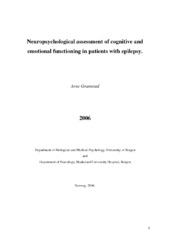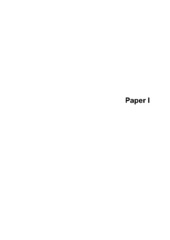| dc.contributor.author | Gramstad, Arne | en_US |
| dc.date.accessioned | 2006-11-21T09:58:56Z | |
| dc.date.available | 2006-11-21T09:58:56Z | |
| dc.date.issued | 2006-08-17 | eng |
| dc.identifier.isbn | 82-308-0203-3 (print version) | en_US |
| dc.identifier.uri | https://hdl.handle.net/1956/1956 | |
| dc.description.abstract | The general aim of the thesis has been to contribute to a deeper understanding of central psychosocial and cognitive problems experienced by patients with epilepsy. In the first paper, the aim was to evaluate the impact of dimensions derived from contemporary personality and social learning theory on psychosocial functioning in patients with epilepsy. The procedure was to correlate scores on scales measuring positive and negative affectivity, self-efficacy and health related locus of control with scores on a multidimensional inventory with established clinical validity in patients with epilepsy. As expected, high correlations were found between negative affectivity and general emotional adjustment, general psychosocial functioning and quality of life. Also, both positive affectivity and self-efficacy explained unique variances of these dimensions in a multiple regression analysis. In the second paper, the aim was to assess whether left side of seizure onset or left hemisphere cognitive functioning best predicted dichotic listening performance in patients with temporal lobe epilepsy and left hemisphere speech dominance. Left hemisphere general functioning predicted dichotic listening results significantly, and to a stronger degree than left-sided seizure onset. In the third paper, the aim was to validate the findings of the second paper in a larger group of patients, and to investigate whether the same effects would be present also under conditions of forced attention in dichotic listening. The effect of left hemisphere dysfunction remained present also in the forced attention conditions, with the strongest effect being an increased tendency to report left ear stimuli. Multiple regression analyses showed that general cognitive factors influenced dichotic listening stronger in the forced-attention conditions than in the nonforced condition. This effect was strongest in the forced-left attention condition. | en_US |
| dc.format.extent | 295742 bytes | eng |
| dc.format.extent | 110853 bytes | eng |
| dc.format.extent | 118984 bytes | eng |
| dc.format.extent | 144846 bytes | eng |
| dc.format.extent | 388819 bytes | eng |
| dc.format.mimetype | application/pdf | eng |
| dc.format.mimetype | application/pdf | eng |
| dc.format.mimetype | application/pdf | eng |
| dc.format.mimetype | application/pdf | eng |
| dc.format.mimetype | application/pdf | eng |
| dc.language.iso | eng | eng |
| dc.publisher | The University of Bergen | eng |
| dc.relation.haspart | Paper 1: Reprinted from Epilepsy Research 46, Gramstad, A.; Iversen, E.; & Engelsen, B.A., The impact of affectivity dispositions, self-efficacy and locus of control on psychosocial adjustment in patients with epilepsy, pp. 53-61. Copyright 2001, with permission from Elsevier. Published version available at: <a href="http://dx.doi.org/10.1016/S0920-1211(01)00261-3" target=_blank>http://dx.doi.org/10.1016/S0920-1211(01)00261-3</a> | en_US |
| dc.relation.haspart | Paper 2: Reprinted from International Journal of Neuroscience 113, Gramstad, A.; Engelsen, B.A.; & Hugdahl, K., Left hemisphere dysfunction affects dichotic listening in patients with temporal lobe epilepsy, pp. 1177-1196. Copyright 2003 Taylor & Francis, reproduced with permission. Published version available at: <a href="http://dx.doi.org/10.1080/00207450390212302"target=_blank>http://dx.doi.org/10.1080/00207450390212302</a> | en_US |
| dc.relation.haspart | Paper 3: Gramstad, A.; Engelsen, B.A.; & Hugdahl, K., Dichotic listeningwith forced attention in patients with temporal lobe epilepsy : significance of left hemisphere dysfunction, pp. 163-170. Pre-print. Accepted for publication in Scandinavian Journal of Psychology. Copyright Blackwell. | en_US |
| dc.title | Neuropsychological assessment of cognitive and emotional functioning in patients with epilepsy | en_US |
| dc.type | Doctoral thesis | |
| dc.subject.nsi | VDP::Medisinske Fag: 700::Klinisk medisinske fag: 750::Nevrologi: 752 | nob |
| dc.subject.nsi | VDP::Samfunnsvitenskap: 200::Psykologi: 260::Biologisk psykologi: 261 | nob |



